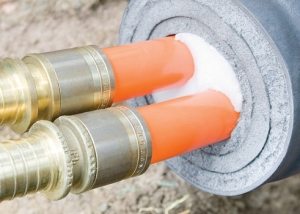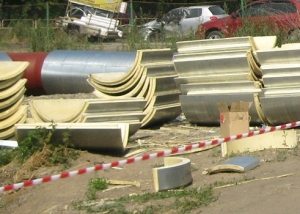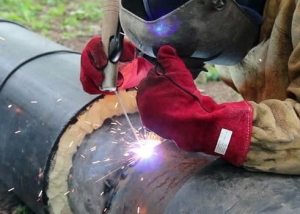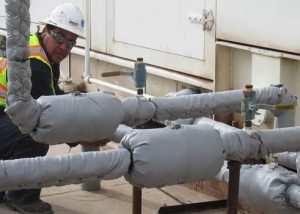A furnished house is a guarantee of a comfortable family life. This is important in the winter, when pipes for water supply and heating must be isolated from the cold and protected from cooling of the coolant. Owners of buildings in the private sector in the cold season have problems with those sections of the pipeline that are laid in the cold basement and attic, in open areas adjacent to the general communications. Water freezes in the system from any material, if the installation of thermal insulation of pipelines has not been completed in advance.

The method of installation of thermal insulation depends on the type of material and the method of laying the pipeline
Content
The main tasks of thermal insulation of pipelines
Based on building codes, when installing any pipeline, it is recommended to use a heater that is suitable for a certain type of communications. These documents also regulate the thickness of thermal insulation of heating pipelines. Insulating materials are available in finished form, convenient for use:
- cylinders, half cylinders;
- winding;
- film;
- insulating paint;
- sprayed insulation.
Thermal insulation materials of the latest generation minimize heat loss in the coolant, increase the efficiency of the pipeline. Convenient forms of release of heaters facilitate the installation of thermal insulation of pipelines.
It is important to properly lay and isolate all communications during installation, excluding “cold bridges” and unprotected sections. Some fragments of the pipeline require double or triple protection with various insulating materials, especially at joints.
The main errors leading to heat loss or freezing of the pipeline:
- lack of knowledge of installation technology;
- incorrect calculation of the insulation layer of pipelines;
- wrong choice of material for insulation.

When choosing an insulating material, one should take into account its properties, thickness, and also the diameter of the pipes that are planned to be insulated
Each thermally insulating material has its own advantages and disadvantages. One pipe insulation has a longer service life, the other is less protected from moisture, so they are often combined for more efficiency. The most important tasks that can be solved by competent installation of thermal insulation of pipelines:
- mechanical protection of pipes against deformation and corrosion;
- increased efficiency during transportation of the coolant;
- heat loss reduction;
- increase the period of uninterrupted operation of pipes that do not require repair;
- minimization of heat exchange with the environment;
- protection against changes in temperature and moisture.
When choosing materials for thermal insulation of pipelines, it is important to consider their parameters:
- resistance to chemicals, mechanical stress;
- indicators of thermal conductivity of insulation;
- resistance to high temperature loads;
- moisture resistance, vapor permeability;
- maintaining the integrity of the coating during compression, tension, increased load;
- refractory properties.
Note! If part of the pipeline in the winter will be on the surface, outside the heated room, the insulation thickness of the heating pipelines or the number of layers should be maximum.

Pipes laid in unheated rooms and along the street must be insulated with the thickest material with a moisture protective layer
In some sections of the pipeline, an alternative to an expensive “shell” can be used. If there are wide sewer or plastic pipes, then they can be cut lengthwise to wrap metal ones. Fill the intermediate space with the remains of mineral wool or with mounting foam (through the clarified holes). The outer layer should be well fixed with construction tape or other reliable winding, better foil.
It is impossible to name any one universal insulation, since the construction market offers various heat-insulating materials for pipelines with many advantages. On the Russian market, you can find imported and domestic thermally insulating materials of famous brands:
- Knauf;
- Ursa;
- Isover.
The isolation of these firms is considered the most practical and effective.
Basalt (mineral) wool insulation
The main form of release is a cylindrical wrapper for pipes based on mineral raw materials. Durable and reliable insulation, in which insects and mice do not start, which is important for installation in basements and attics. Despite the appearance of mineral wool, thermal insulation of pipelines with its use guarantees long-term and flawless operation. Finished molded elements are sold for pipes of different diameters, so when buying, it is important to know the parameters of the water supply. In case of mechanical impacts on the outside of the communications, basalt wool rolls should be protected with a layer of reflective foil. There are offers with a ready-made protective layer, for example, from foil isol or glassine.
Installation: Finished fragments are wrapped around pipes, fixed with a tape of tape, sometimes plastic ties or ribbons are used.
Fiberglass Insulation
The most affordable material, produced on the basis of quartz sand, but the obsolete glass wool is prohibited in many countries. This insulation is inexpensive, but over time, this insulation is compacted, its effectiveness decreases. Outside, an additional winding, for example, fiberglass, is mandatory.
Attention! Microscopic glassy filaments are dangerous for the skin, so when laying such a heater it is important to take care of protecting the skin of the hands, face, and the whole body.
Installation: A small layer of glass wool is wrapped around the heating pipes and closed with non-absorbent material. Outside, they wrap with foil, roofing material.
Styrofoam shell
This is an improved type of polystyrene used for pre-insulated pipes or heaters in the form of cylinders and half cylinders. Reuse is possible if you have to open the pipeline to eliminate leaks or dismantling. Available with or without an outer protective layer.
Installation: Laying the shell is easiest to do, thanks to a well-designed form of release. Styrofoam cylinders are suitable for terrestrial communications and underground (channel) pipe laying. They are covered by halves of a shell suitable for the width of the pipe and fixed. Foiled adhesive tape is applied in a spiral tightly fitting layers.
In order to ensure "overlap" of shell fragments during the installation of thermal insulation of pipelines, it is better to move the halves relative to the second part. After wrapping with foil tape, the insulation can be considered completed.
It's important to know! Like the halves of an expanded polystyrene shell, molded half-cylinders of other materials, such as foam rubber or foam, are laid. Foamed polyethylene is available in the form of a multicomponent base for foil insulation. And without an additional layer, it gradually deforms, coalesces and spreads at the junction.

Factory “shell” made of expanded polystyrene is easy to install, thanks to special grooves on each segment
Sprayable Polyurethane Foam
Convenient form of release - a two-component mixture is sprayed from a special device through a nozzle. It is applied on any inclined surface or in inaccessible places of warehouse, attic and other auxiliary rooms. The use of foamed materials such as sprayed polyurethane foam when laying underground communications is not advisable. The porous material is compacted under soil pressure, so it loses its properties and becomes ineffective
Installation: Thermal insulation by spraying in the form of snow foam can be made not only on the surface of the pipes, but also on any freezing surface. The dense white foam forms excellent adhesion to metal (steel) pipes.
Advice! Such work can be done independently (if you have basic skills) or entrusted to a profile company. In the absence of experience, there will be a large consumption of foam and an uneven layer when applied. It is advisable to practice a few square meters of area before a full thermal insulation of the pipeline.
Heat insulating paint
Innovation in the domestic construction market - white or gray paste based on a multicomponent mixture of acrylic and synthetic fillers. It tolerates temperature jumps, perfectly protects the metal from corrosion and the formation of condensate.
Installation: Apply with a special spray in several layers to provide better insulation. It is advisable to treat well-cleaned pipes with a primer for painting metal.
With any method of processing pipes, it is important to check the tightness of the communications, clean the pipes from rust, you can apply a primer and treat the insulation with all the installation rules. Pipeline insulation high-tech materials ensures a private home uninterrupted supply of cold water and efficient heating.





